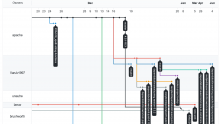Evaluate Rya an alternative to Virtuoso with a hadoop based columnar store that scales easily.
"Apache Rya is a scalable RDF Store that is built on top of a Columnar Index Store (such as Accumulo). It is implemented as an extension to RDF4J to provide easy query mechanisms (SPARQL, SERQL, etc) and Rdf data storage (RDF/XML, NTriples, etc)."
Pro:
- scales by having Accumulo which is build on Hadoop cluster
- has SPARQL endpoint
- Apache top-level project
Con:
- no commits since dec 2020
- few stars and forks in Github
See also https://www.wikidata.org/wiki/Wikidata:WikiProject_Limits_of_Wikidata#Apache_Rya
